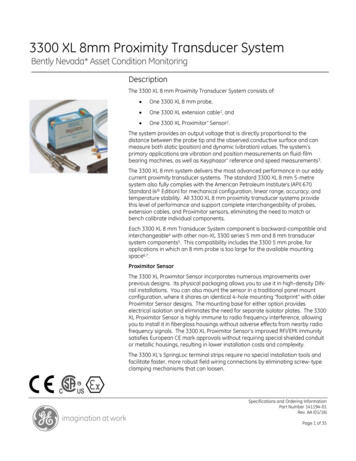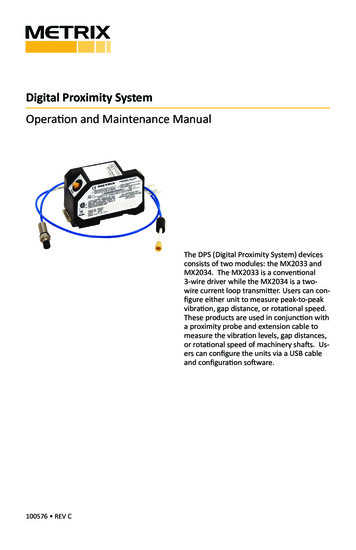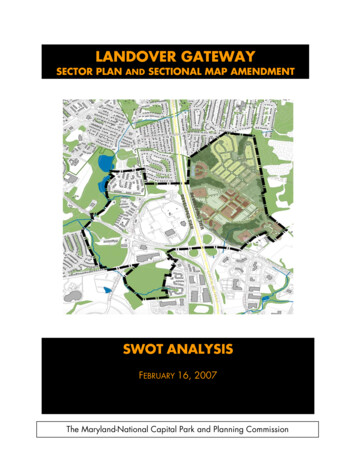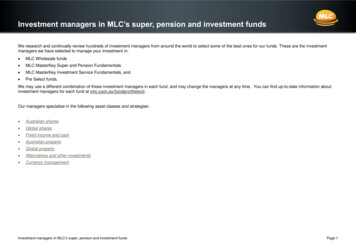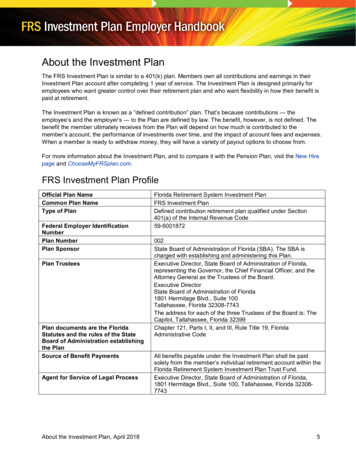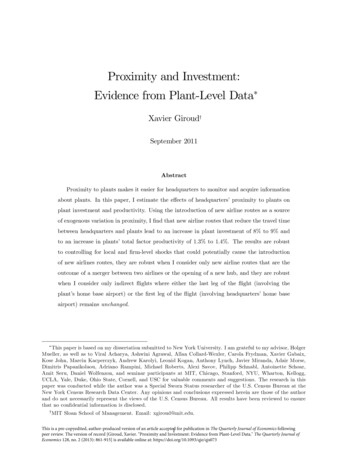
Transcription
Proximity and Investment:Evidence from Plant-Level Data Xavier Giroud†September 2011AbstractProximity to plants makes it easier for headquarters to monitor and acquire informationabout plants. In this paper, I estimate the effects of headquarters’ proximity to plants onplant investment and productivity. Using the introduction of new airline routes as a sourceof exogenous variation in proximity, I find that new airline routes that reduce the travel timebetween headquarters and plants lead to an increase in plant investment of 8% to 9% andto an increase in plants’ total factor productivity of 1.3% to 1.4%. The results are robustto controlling for local and firm-level shocks that could potentially cause the introductionof new airlines routes, they are robust when I consider only new airline routes that are theoutcome of a merger between two airlines or the opening of a new hub, and they are robustwhen I consider only indirect flights where either the last leg of the flight (involving theplant’s home base airport) or the first leg of the flight (involving headquarters’ home baseairport) remains unchanged. This paper is based on my dissertation submitted to New York University. I am grateful to my advisor, HolgerMueller, as well as to Viral Acharya, Ashwini Agrawal, Allan Collard-Wexler, Carola Frydman, Xavier Gabaix,Kose John, Marcin Kacperczyk, Andrew Karolyi, Leonid Kogan, Anthony Lynch, Javier Miranda, Adair Morse,Dimitris Papanikolaou, Adriano Rampini, Michael Roberts, Alexi Savov, Philipp Schnabl, Antoinette Schoar,Amit Seru, Daniel Wolfenzon, and seminar participants at MIT, Chicago, Stanford, NYU, Wharton, Kellogg,UCLA, Yale, Duke, Ohio State, Cornell, and USC for valuable comments and suggestions. The research in thispaper was conducted while the author was a Special Sworn Status researcher of the U.S. Census Bureau at theNew York Census Research Data Center. Any opinions and conclusions expressed herein are those of the authorand do not necessarily represent the views of the U.S. Census Bureau. All results have been reviewed to ensurethat no confidential information is disclosed.†MIT Sloan School of Management. Email: xgiroud@mit.edu.This is a pre-copyedited, author-produced version of an article accepted1 for publication in The Quarterly Journal of Economics followingpeer review. The version of record [Giroud, Xavier. "Proximity and Investment: Evidence from Plant-Level Data." The Quarterly Journal ofEconomics 128, no. 2 (2013): 861-915] is available online at: https://doi.org/10.1093/qje/qjs073
1IntroductionProximity facilitates monitoring and access to information. For instance, venture capitalistsare more likely to serve on the boards of local firms, where monitoring is easier (Lerner, 1995).Likewise, mutual fund managers are more likely to hold shares of local firms–and they earnsubstantial abnormal returns from these investments–suggesting “improved monitoring capabilities or access to private information of geographically proximate firms” (Coval and Moskowitz,1999, 2001 (p. 812)). Finally, banks located closer to their borrowers are more likely to lend toinformationally difficult borrowers, e.g., borrowers without any financial records (Petersen andRajan, 2002; Mian, 2006; Sufi, 2007).All of the above examples come from arm’s length transactions. Much less, if anything, isknown about the role of proximity within firms. For instance, is it true that–in analogy to theempirical findings in the mutual funds and banking literatures–headquarters is more likely toinvest in plants that are located closer to headquarters? And does proximity to headquartersimprove plant productivity? Understanding plant investment and productivity is important, notthe least because they affect economic growth.1 One difficulty in answering these questions isthat they require data on the locations of plants and headquarters. Another, more serious issueis that the locations of plants and headquarters are choice variables. Accordingly, commonlyused proxies for proximity–such as the physical distance between plants and headquarters–arelikely to be endogenous, making it difficult to establish causality.In this paper, I attempt to address both of these issues. As for the first issue, I use plant-leveldata provided by the U.S. Census Bureau for the manufacturing sector for the period 1977 to2005, which include the locations of plants and headquarters. As for the second issue, I noticethat the main reason why empirical studies are interested in (geographical) proximity is becauseit proxies for the ease of monitoring and acquiring information. I argue that a more direct proxyis travel time. For instance, a plant may be located far away from headquarters, yet monitoringmay be easy, because there exists a short, direct flight. Conversely, a plant may be located in the1Anecdotal evidence suggests that proximity to headquarters is a potentially important determinant of plantinvestment. For instance, when Tesla Motors decided on the location of a manufacturing plant to produce itselectric Tesla roadster, it announced that the plant would be located “as close to our headquarters as possible,”citing as a reason “to keep better control over production” (Silicon Valley/San Jose Business Journal, June30, 2008). As for the effects of proximity on productivity, Ray Kroc, the founder of McDonald’s, writes inhis autobiography: “One thing I liked about that house was that it was perched on a hill looking down on aMcDonald’s store on the main thoroughfare. I could pick up a pair of binoculars and watch business in that storefrom my living room window. It drove the manager crazy when I told him about it. But he sure had one hell ofa hard-working crew!” (Kroc, 1992, p. 141).2
same state as headquarters, yet monitoring may be costly, because it involves a long and tediousroad trip. Of course, in the cross-section, geographical proximity and travel time are highlycorrelated. However, the advantage of using travel time is that it entails plausibly exogenousvariation, allowing me to address the endogeneity issue.Specifically, I combine the Census plant-level data with airline data from the U.S. Departmentof Transportation, which contain information about all flights that have taken place betweenany two airports in the U.S. The source of exogenous variation that I exploit is the introductionof new airline routes that reduce the travel time between headquarters and plants. Using adifference-in-differences approach, I find that the introduction of new airline routes leads to anincrease in plant investment of 8% to 9%, corresponding to an increase in capital expendituresof 213,000 to 239,000 (in 1997 dollars). Moreover, I find that plants’ total factor productivityincreases by 1.3% to 1.4%, corresponding to an increase in plant profits of 67,000 to 93,000(in 1997 dollars). In both cases, the effect is stronger for larger reductions in travel time, and itis only significant for travel time reductions of at least two hours round trip.My identification strategy can be illustrated with a simple example. Consider a companywith headquarters in Boston and a plant in Memphis. In 1985, the fastest way to travel fromBoston to Memphis was an indirect flight with one stopover in Atlanta. In 1986, NorthwestAirlines opened a new hub in Memphis and started operating direct flights between Boston andMemphis. The introduction of this new airline route substantially reduced the travel betweenthe Boston headquarters and the Memphis plant and is coded as a “treatment” of the Memphisplant.2 To measure the effect of this treatment on, e.g., investment, one could simply compareinvestment at the Memphis plant before and after 1986. However, other events in 1986 mighthave also affected investment at the Memphis plant. For instance, there might have been anationwide surge in investment due to favorable economic conditions or low interest rates. Toaccount for this possibility, I include a control group that consists of all plants that have not(yet) been treated. I then compare the difference in investment at the Memphis plant beforeand after 1986 with the difference in investment at the control plants before and after 1986.The difference between the two differences is the estimated effect of the introduction of the newairline route between Boston and Memphis on investment at the Memphis plant.An important concern is that local shocks in the plants’ vicinity or firm-level shocks could2Overall, there are 10,533 plants in my sample that experience a reduction in the travel time to headquartersdue to the introduction of new airline routes.3
be driving both the introduction of new airline routes and plant investment. For instance,suppose the Memphis area experiences an economic boom. As the local economy is booming,the company headquartered in Boston may find it more attractive to increase investment at theMemphis plant. At the same time, airlines may find it more attractive to introduce new flightsto Memphis. In this case, finding a positive treatment effect would be a spurious outcome ofan omitted shock in the Memphis area. Likewise, it is easy to construct examples in which anomitted firm-level shock gives rise to a spurious treatment effect.Given that omitted local and firm-level shocks can lead to spurious treatment effects, itis important to control for such shocks. Since a treatment is uniquely defined by two (airport) locations–the locations of the plant’s and headquarters’ airports–I can do this, makingthe identification tighter. Specifically, I include MSA-year and firm-year controls in all my regressions. Both types of controls are identified here, because not all local plants have theirheadquarters in the same city or region, and because not all plants of a company are affectedby the introduction of a new airline route.While the inclusion of MSA- and firm-year controls accounts for the possibility of omittedlocal and firm-level shocks, it remains the possibility of an omitted shock that is specific to asingle plant–i.e., the shock does not affect other plants in the same region. In response tothis shock, headquarters may increase investment at the plant. At the same time, the plantmay lobby for the introduction of a new airline route to its headquarters. Unlike the localand firm-level shocks described above, such plant-specific shocks–provided they lead to theintroduction of a new airline route to headquarters–are collinear with the treatment. Hence,neither MSA-year controls nor firm-year controls can account for them.I address this issue in three different ways. First, I consider the dynamic effects of theintroduction of new airline routes. If a new airline route is the (endogenous) outcome of a preexisting plant-specific shock, then I should find an “effect” of the treatment already before thenew airline route is introduced. However, I find no such effect. On the contrary, I find that plantinvestment (productivity) increases only with a lag of six to twelve (twelve to eighteen) monthsafter the introduction of the new airline route, implying there is no “effect” either before orimmediately after. Second, I show that my results are robust when I consider only new airlineroutes that are the outcome of a merger between two airlines or the opening of a new hub.Arguably, it is less likely that a shock to a single plant–but not to other plants in the same4
region–would trigger an airline merger or the opening of a new hub. Third, I show that myresults are robust when I consider only indirect flights where the last leg of the flight (involvingthe plant’s home base airport) remains unchanged. Arguably, it is less likely that a single plantcan successfully lobby for the introduction of a new flight elsewhere–i.e., a flight that does notinvolve its home base airport.In the final part of my study, I provide additional evidence supporting the notion that areduction in travel time facilitates monitoring and information acquisition. For instance, I showthat my results are stronger for plants whose headquarters is more “time-constrained,” basedon the notion that time constraints limit the ability to monitor and acquire information aboutplants. I also show that my results are stronger in the earlier years of the sample period, whereother, non-personal means of exchanging information (e.g., internet, corporate intranet, videoconferencing) were either unavailable or less developed.The rest of this paper is organized as follows. Section 2 describes the data and empiricalmethodology. Section 3 presents the main results. Section 4 contains robustness checks. Section5 considers heterogeneity in the treatment effect. Section 6 concludes. The Appendix providesinformation regarding the construction and measurement of variables.22.1DataData Sources and Sample SelectionA. Plant-level DataThe data on manufacturing plants are obtained from three different data sets provided by theU.S. Census Bureau. The first data set is the Census of Manufactures (CMF). The CMFcovers all U.S. manufacturing plants with at least one paid employee. The CMF is conductedevery five years in years ending with 2 and 7 (“Census years”). The second data set is theAnnual Survey of Manufactures (ASM). The ASM is conducted in all non-Census years andcovers a subset of the plants covered by the CMF: plants with more than 250 employees areincluded in every ASM year, while plants with fewer employees are randomly selected everyfive years, where the probability of being selected is higher for larger plants. Although theASM is referred to as a “survey,” reporting is mandatory, and fines are levied for misreporting.The CMF and ASM cover approximately 350,000 and 50,000 plants per year, respectively, and5
contain information about key plant variables, such as capital expenditures, total assets, valueof shipments, material inputs, employment, industry sector, and location. The third data setis the Longitudinal Business Database (LBD), which is compiled from the Business Register.The LBD is available annually and covers all U.S. business establishments with at least onepaid employee.3 The LBD contains longitudinal establishment identifiers along with data onemployment, payroll, industry sector, location, and corporate affiliation. I use the longitudinalestablishment identifiers to construct longitudinal linkages between the CMF and ASM.Given that the LBD covers the entire U.S. economy, it also contains information about nonmanufacturing establishments of companies that have plants in either the CMF or the ASM. Iuse this information to construct firm-level variables, such as the total number of employees andthe number of establishments per firm. For my analysis, the most important firm-level variable isthe ZIP code of the company’s headquarters. At the firm level, the Census Bureau distinguishesbetween single- and multi-unit firms. Single-unit firms consist of a single establishment, whichmeans headquarters and the plant are located in the same unit. Multi-unit firms consist of twoor more LBD establishments, with one establishment being the company’s headquarters.To determine the location of headquarters, I supplement the LBD with data from two otherdata sets provided by the Census Bureau: the Auxiliary Establishment Survey (AES) andthe Standard Statistical Establishment List (SSEL). The AES contains information on nonproduction (“auxiliary”) establishments, including information on headquarters. The SSELcontains the names and addresses of all U.S. business establishments. Appendix A outlines theprocedure used to obtain the location of headquarters from these data sets. The main source ofinformation about headquarters, the AES, is available every five years between 1977 and 2002.To fill in the missing years, I always use the information from the latest available AES. Giventhat the Census years are deterministic, this measurement error is unlikely to introduce anybias. It merely introduces noise into the regression, which makes it harder for me to find anysignificant results.My sample covers the period from 1977 to 2005. (1977 is the first available AES year; 2005is the last available ASM year.) To be included in my sample, I require that a plant has aminimum of two consecutive years of data. Following common practice in the literature (e.g.,Foster, Haltiwanger, and Syverson, 2008), I exclude plants whose information is imputed from3An establishment is a “single physical location where business is conducted” (Jarmin and Miranda, 2003, p.15). Establishments are the economic units used in the Census data sets.6
administrative records rather than directly collected. I also exclude plant-year observations forwhich employment is either zero or missing. Finally, to ensure that the physical distance betweenplants and headquarters is comparable across years, I exclude firms that change the location ofheadquarters during the sample period (7% of the firms in my sample). The results are virtuallyidentical if I include these firms.The above selection criteria leave me with 1,332,824 plant-year observations. In my regressions, I use a 10-year window around the treatment date, meaning treated plants are includedfrom five years before the treatment to five years after the treatment. Using a 10-year treatmentwindow reduces my sample only slightly, leaving me with a final sample of 1,291,280 plant-yearobservations. That said, the length of the treatment window is immaterial for my results. Allresults are similar if I use a different treatment window or no treatment window at all, meaningall plant-year observations of treated plants are included either before or after the treatment.B. Airline DataThe data on airline routes are obtained from the T-100 Domestic Segment Database (for theperiod 1990 to 2005) and ER-586 Service Segment Data (for the period 1977 to 1989), which arecompiled from Form 41 of the U.S. Department of Transportation (DOT).4 All airlines operatingflights in the U.S. are required by law to file Form 41 with the DOT and are subject to fines formisreporting. Strictly speaking, the T-100 and ER-586 are not samples: they include all flightsthat have taken place between any two airports in the U.S.The T-100 and ER-586 contain monthly data for each airline and route (“segment”). Thedata include, e.g., the origin and destination airports, flight duration (“ramp-to-ramp time”),scheduled departures, performed departures, enplaned passengers, and aircraft type.2.2Empirical MethodologyThe introduction of new airline routes that reduce the travel time between headquarters andplants makes it easier for headquarters to monitor and acquire information about plants. To examine the effects on plant investment and productivity, I use a difference-in-differences approach.4The T-100 Domestic Segment Database is provided by the Bureau of Transportation Statistics. The annualfiles of the ER-586 Service Segment Data are maintained in the form of magnetic tapes at the U.S. NationalArchives and Records Administration (NARA). I obtained a copy of these tapes from NARA.7
Specifically, I estimate: treatment γ 0 X (1)where indexes plants, indexes firms, indexes plant location, indexes years, is thedependent variable of interest (plant investment or productivity), and are plant and yearfixed effects, treatment is a dummy variable that equals one if a new airline route that reducesthe travel time between plant and its headquarters has been introduced by time , X is avector of control variables, and is the error term. Location is defined at the MetropolitanStatistical Area (MSA) level.5 The main coefficient of interest is , which measures the effectsof the introduction of new airline routes.If the relationship between plants and headquarters is governed by symmetric informationand no agency problems, then the introduction of new airline routes should not matter. Inall other cases, it might matter. For instance, headquarters may invest more in plants thatare easier to monitor and less likely to have private information.6 Likewise, better monitoringmay improve plant managers’ incentives, and learning about a plant may allow headquarters toimprove plant productivity. On the other hand, if headquarters becomes “too well informed”or “monitors too much,” this may impair plant managers’ incentives to create new investmentopportunities (Aghion and Tirole, 1997) or work hard in general (Crémer, 1995).My identification strategy can be illustrated with a simple example. Suppose a companyheadquartered in Boston has a plant located in Memphis. In 1985, no direct flight was offeredbetween Boston Logan International Airport (BOS) and Memphis International Airport (MEM).The fastest way to connect both airports was an indirect flight operated by Delta Airlines witha stopover in Atlanta. In 1986, Northwest Airlines opened a new hub in MEM. As part of this5As defined by the Office of Management and Budget, an MSA consists of a core area that contains asubstantial population nucleus together with adjacent communities that have a high degree of social and economicintegration with that core. MSAs include one or more counties, and some MSAs contain counties from severalstates. For instance, the New York MSA includes counties from four states: New York, New Jersey, Connecticut,and Pennsylvania. Since MSAs represent economically integrated areas, they are likely to be affected by the samelocal shocks. By definition, the MSA classification is only available for urban areas. For rural areas, I considerthe rural part of each state as a separate region. There are 366 MSAs in the U.S. and 50 rural areas based onstate boundaries. (The District of Columbia has no rural area.) For expositional simplicity, I refer to these 416geographical units as “MSAs.”6A standard result in the capital budgeting literature with asymmetric information is that there is likelyto be underinvestment under the optimal mechanism (e.g., Harris and Raviv, 1996; Malenko, 2011). See alsoSeru (2010), who provides empirical evidence consistent with the idea that headquarters is less likely to investin projects that rely on division managers’ private information. Likewise, moral hazard, which can be alleviatedthrough monitoring, typically leads to underinvestment in equilibrium (e.g., Tirole, 2006, Chapters 3 and 4).8
expansion, Northwest started operating direct flights between BOS and MEM as of October1986. The introduction of this new airline route reduced the travel time between BOS andMEM and is coded as a “treatment” of the Memphis plant in 1986.To measure the effect of this treatment on, e.g., investment, one could simply compareinvestment at the Memphis plant before and after 1986. However, other events in 1986 mighthave also affected investment at the Memphis plant. For instance, there might have been anationwide surge in investment due to favorable economic conditions or low interest rates. Toaccount for this possibility, I include a control group that consists of all plants that have not(yet) been treated. Due to the staggering nature of the introduction of new airline routes,a plant remains in the control group until it is treated (which, for some plants, is never). Ithen compare the difference in investment at the Memphis plant before and after 1986 with thedifference in investment at the control plants before and after 1986. The difference between thetwo differences is the estimated effect of the introduction of the new airline route between BOSand MEM on investment at the Memphis plant.Airlines’ decisions to introduce new routes depend on several factors, including economicand strategic considerations as well as lobbying. As long as these factors are unrelated to plantinvestment or productivity, this is not a concern. However, if there are (omitted) factors thatare driving both the introduction of new airline routes and plant investment or productivity,then any relationship between the two could be spurious. I now discuss how my identificationstrategy can account for such omitted factors at the local, firm, and plant level.A. Local ShocksTo continue with the above example, suppose the Memphis area experiences an economic boom.As the local economy is booming, the company headquartered in Boston may find it moreattractive to increase investment at the Memphis plant. At the same time, airlines may find itmore attractive to introduce new flights to Memphis. Since a treatment is uniquely defined bytwo (airport) locations–the locations of the plant’s and headquarters’ airports–I can controlfor such local shocks, thereby separating out the effects of the introduction of new airline routesfrom the effects of contemporaneous local shocks.Suppose, for instance, that another plant, which is also located in Memphis, has its headquarters in Chicago. (The travel time between Chicago and Memphis was not affected by theintroduction of new airline routes between 1985 and 1986.) If investment at this other Memphis9
plant also increases in 1986, then an increase in investment at the first Memphis plant (withheadquarters in Boston) might not be due to the newly introduced airline route between MEMand BOS but rather due to a contemporaneous shock in the Memphis area. In principle, I couldcontrol for such local shocks by including a full set of MSA fixed effects interacted with year fixedeffects. Unfortunately, computational constraints make it impossible to estimate a specificationwith so many fixed effects.7 Instead, I adopt the methodology in Bertrand and Mullainathan(2003) and account for local shocks by including “MSA-year” controls, which are computed asthe mean of the dependent variable (e.g., plant investment) in the plant’s MSA in a given year,excluding the plant itself.An alternative way to account for local shocks is to focus only on new airline routes whoseintroduction is unlikely to be driven by such shocks. Specifically, in a subset of cases, a newindirect flight replaces a previously optimal indirect flight, but the last leg of the flight–i.e.,the leg involving the plant’s home base airport–remains unchanged. For instance, suppose thecompany headquartered in Boston has another plant in Little Rock. In 1985, the fastest way toconnect Boston Logan International Airport (BOS) and Little Rock National Airport (LIT) wasan indirect flight with stopovers in Atlanta (ATL) and Memphis (MEM). In 1986, NorthwestAirlines started operating direct flights between BOS and MEM (see above) with the effect thatthe previously optimal indirect flight BOS-ATL-MEM-LIT is replaced with a new, faster indirectflight BOS-MEM-LIT. Importantly, the last leg of the flight–between MEM and LIT–remainsunchanged; all that has changed is the connection between BOS and MEM. Arguably, it is ratherunlikely that a local shock in the Little Rock area would be responsible for the introduction of anew airline connection between Boston and Memphis. As I show in robustness checks, I obtainvery similar results if I consider only new airline routes where the last leg of the flight remainsunchanged.7Such computational constraints are typical of so-called “3-way fixed effect models,” i.e., models includingindividual fixed effects, time fixed effects, and additional group fixed effects (here: plant, year, and MSA yearfixed effects). The common way to estimate 3-way fixed effect models is to include the time and additional groupfixed effects as dummy variables and eliminate the individual fixed effects via the within transformation. However,doing so can be computationally difficult if the number of additional group fixed effects is large. (For a discussion,see Abowd, Kramarz, and Margolis (1999) and Bertrand and Mullainathan (2003).) In my case, accounting fortime-varying shocks at the MSA level via MSA year fixed effects would require the inclusion of 416 MSAs 29 years 12,064 additional fixed effects. While the use of high-performance multi-core processors can helpovercome this limitation, the computing resources at the Census research data center where this research wasundertaken were insufficient to handle this task. One way to reduce the computational burden is to use a coarserdefinition of location, such as the nine Census regions. This requires only the inclusion of 9 regions 29 years 261 additional fixed effects. I have done this, and all my results are similar. However, it is questionable whethera coarse definition of location based on the nine Census regions is sufficient to filter out local shocks.10
B. Firm-Level ShocksI am also able to control for firm-level shocks, thereby separating out the effects of the introduction of new airline routes from the effects of contemporaneous firm-level shocks. For instance,suppose the company headquartered in Boston has another plant in Queens in New York City.(The travel time between Queens and Memphis was not affected by the introduction of newairline routes between 1985 and 1986.) If investment at the Queens plant also increases in 1986,then an increase in investment at the Memphis plant might not be due to the newly introducedairline route between MEM and BOS but rather due to a contemporaneous shock at the firmlevel. Analogous to the construction of the MSA-year controls, I can account for firm-levelshocks by including “firm-year” controls, which are computed as the mean of the dependentvariable across all of the firm’s plants in a given year, excluding the plant itself.As in the case of local shocks, an alternative way to account for firm-level shocks is tofocus only on new airline routes whose introduction is unlikely to be driven by such shocks.Specifically, in a subset of cases, a new indirect flight replaces a previously optimal indirectflight, but the first leg of the flight–i.e., the leg involving headquarters’ home base airport–remains unchanged. As I show in robustness checks, I obtain very similar results if I focus onlyon this subset of new airline routes.C. Plant-Specific S
I then compare the difference in investment at the Memphis plant before and after 1986 with the difference in investment at the control plants before and after 1986. The difference between the two differences is the estimated effect of the introduction of the new airline route between Boston and Memphis on investment at the Memphis plant.
